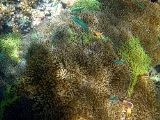
Stichodactyla mertensii
Encyclopedia
Merten's carpet sea anemone, Stichodactyla mertensii, is regarded as the largest sea anemone with a diameter of over 1 m, the next largest being Heteractis magnifica
which has longer tentacles. This species has an oral disc that can be described as more ovoid than circular that contours to the surrounding substrate and is attached to the substrate by adhesive verrucae, which are wart like projections. Its blunt or pointed tentacles are uniformly shaped, and are only about 1–2 cm (0.393700787401575–0.78740157480315 ) long. While this species can be confused with Stichodactyla gigantea
and S. haddoni, they are most easily distinguished by habitat since the former two prefer sand while S. mertensii prefers rocky or coral substrate. It contains obligate symbiotic zooxanthellae, and can serve as a host anemone to 17 separate fish species, the majority of which are anemonefish, with one damselfish
.
Fish associated with S. mertensii include
Heteractis magnifica
Heteractis magnifica, also known by the common names magnificent sea anemone or Ritteri anemone, is a species of sea anemone that lives in the Indo-Pacific area, and can grow up to 1 metre in diameter in the wild. It can be kept in aquaria but is considered one of the most challenging species...
which has longer tentacles. This species has an oral disc that can be described as more ovoid than circular that contours to the surrounding substrate and is attached to the substrate by adhesive verrucae, which are wart like projections. Its blunt or pointed tentacles are uniformly shaped, and are only about 1–2 cm (0.393700787401575–0.78740157480315 ) long. While this species can be confused with Stichodactyla gigantea
Stichodactyla gigantea
Stichodactyla gigantea, commonly known as the giant carpet anemone is a species of sea anemone that lives in the Indo-Pacific area, with a diameter usually no larger than 50 centimetres and a maximum of 80 centimetres. It can be kept in an aquarium but is a very challenging species to keep alive...
and S. haddoni, they are most easily distinguished by habitat since the former two prefer sand while S. mertensii prefers rocky or coral substrate. It contains obligate symbiotic zooxanthellae, and can serve as a host anemone to 17 separate fish species, the majority of which are anemonefish, with one damselfish
Damselfish
Damselfish comprise the family Pomacentridae except those of the genera Amphiprion and Premnas. They can grow up to long. While most are marine, a few species inhabit the lower stretches of rivers in freshwater. Damselfish usually have bright colors. in tropical coral reefs, and many of those are...
.
Fish associated with S. mertensii include
|
|

